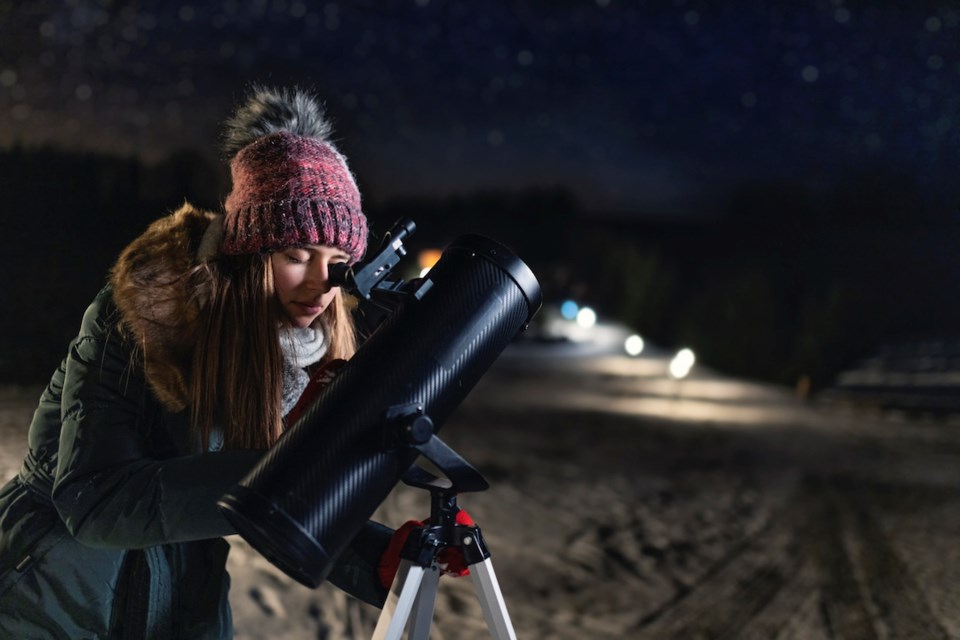This month’s article is mostly about our moon’s passes by various objects, with a bit of extra detail about one of them – the star Regulus. The evening series of ISS passes in January end with single views on Feb. 1 and 2, both passing low in the southwest. Morning passes begin about mid-February for all the morning people out there. Check the Heavens-Above website for information on these.
Venus has passed Earth and is moving to the far side of the solar system, appearing closer to the sun as it goes. Mercury did a brief appearance near it in January but that part of the ecliptic is almost level with our horizon so neither planet was very high in the sky before sunrise. Another conjunction of Venus, this time with Mars, occurs on the morning of Feb. 22 at about 06:45, when the two planets are less than a degree apart. This will be a tough one to see, though, since both are very low in the morning twilight and Mars is about one-hundredth as bright as Venus. It would look a lot better from Australia, of course; both planets would be directly above the sun and a lot higher in the sky. Oh well.
The last quarter moon starts off this month, passing about a degree left of Spica in Virgo as it rises after midnight on Feb. 1. By Feb. 4 and 5, it passes Antares in Scorpio and actually occults it. We won’t see it, however, because instead of 30,000 feet of cloud, we’ll have a few thousand miles of rock in the way. Most of Asia should have a better view.
Lunar perigee occurs Feb. 10, one day after the new moon so we’ll have higher than usual spring tide ranges for a few days. By Feb. 14 evening, the moon is about four degrees right of Jupiter. From my understanding of Greek mythology, if I were Selene, the moon goddess, I’d keep my distance from the king of the gods, but who am I to judge. In the evening of Feb. 16, the moon is just a few degrees left of the Pleiades cluster. By Feb. 19 and 20, it passes through Gemini just three degrees below Pollux, one half of the Twins – Castor and Pollux. Feb. 23 brings the nearly full moon just three degrees left of Regulus. Coincidentally, the official full moon at 04:30 the next morning is just about at lunar apogee – it’s farthest point from Earth. Since it’s the smallest full moon of the year, I’d like to nominate it as an UnSuper Moon, okay?
Incidentally, the star Regulus, the brightest and the “Heart” of Leo, is unusual in several ways. First, it’s almost exactly on the Ecliptic, the path in the sky traced by our sun’s apparent motion as we orbit it. That means that most solar system objects pass close to it or in front of it at some time. The first time I saw that was about 40 years ago one night driving in Saudi Arabia, when I noticed the quarter moon getting closer and closer to a bright star. I missed the actual occultation, though, because you don’t take your eyes off the road ever when driving there, but since then I’ve seen a few and the star just blinks out! And that’s how you realize you actually can see the moon moving through the field of stars.
The second weird thing about Regulus is that it’s spinning unbelievably fast. The main pair of stars is a blue sub-giant A (what we see) and a white dwarf companion B (which we don’t). The main star is about 3.8 times the sun’s mass and shouldn’t be long-lived enough to have a white dwarf companion. The current theory is that Regulus A was less massive and slow burning until the companion star aged, burned hotter, swelled into a giant and lost its outer layers to its partner, Regulus A. Conservation of angular momentum means that the orbital momentum of that falling gas was transferred to Regulus A, which added mass and spun it up to its current high speed. It is currently rotating about once every 15 hours compared to 25 days for our sun. That high rotation speed stretches it out such that its equatorial radius is about twice that of its polar radius and its atmosphere at that equator is just about up to orbital velocity. I picture it as what might happen if the guy working in the pizzeria could spin that dough really, really fast as he tossed it in the air.
In news unrelated to the upcoming high tides the SCAC monthly meeting will not be at the Sechelt Library this month because of their recent tsunami event. Please check the club website at: sunshinecoastastronomy.wordpress.com/ for news.



